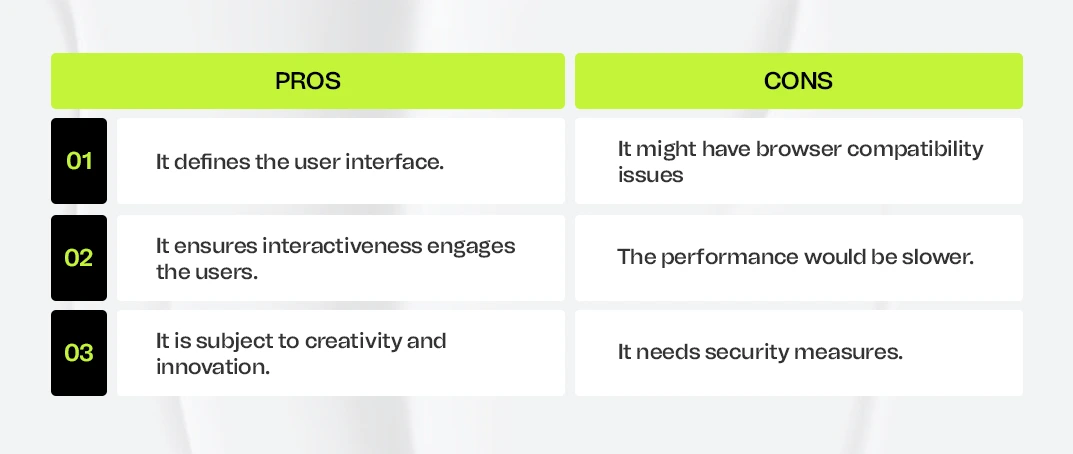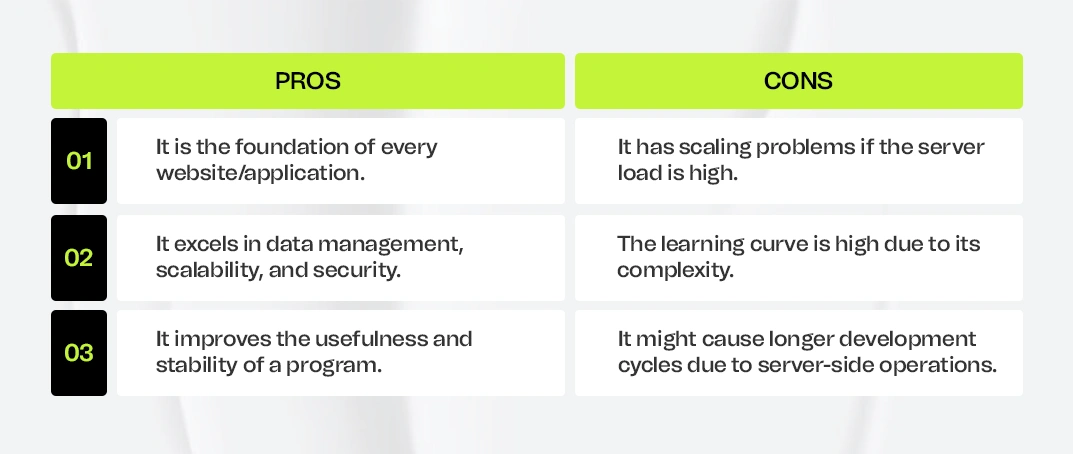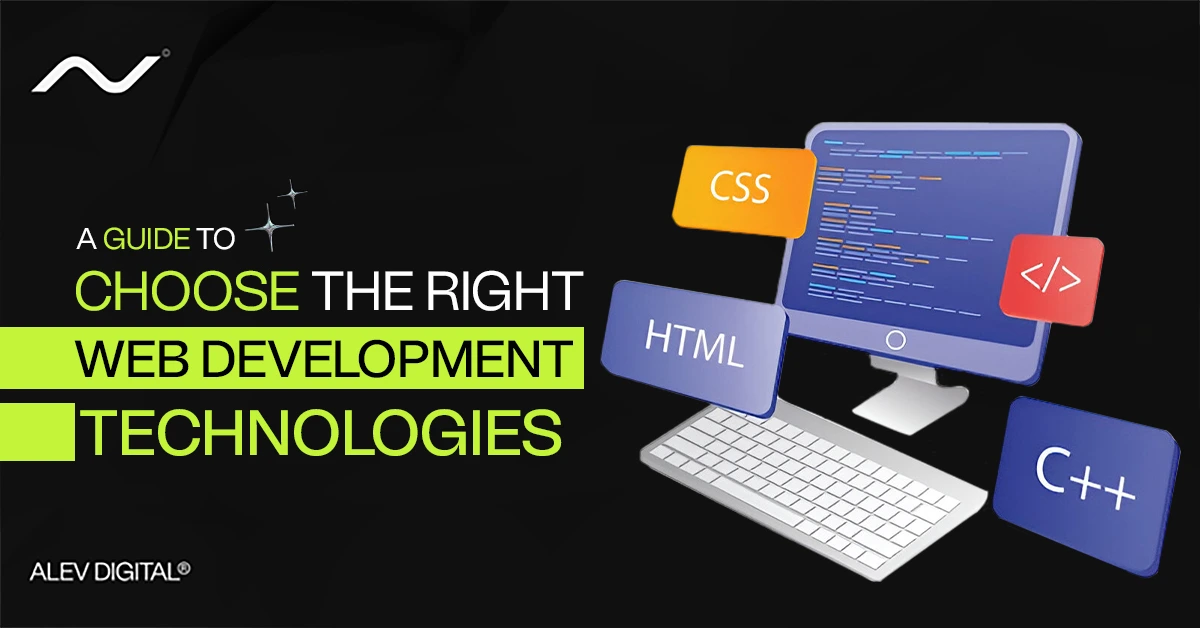For users, the website functionality has everything to do with conversion. However, as a small business owner, you might not know which web development technology fits you. You almost feel lost with so many technologies floating around and programming languages. The piece to this jigsaw puzzle would be picking the one with the language you know the best.
With the advancement of the tech sector, people always wish to get the most interactive and feature-rich website. However, the type of programming language has to be one that you are more proficient in. Besides that, the ease of use and adaptability to your needs are worth counting.
To understand web development technologies better and determine the metrics that help you choose the right one, read this detailed insight.
What Is Web Development?
Web development is crucial as the key product for any business to gain online visibility and be seen as an approachable brand. It refers to the tasks associated with creating, building, and maintaining web applications (online); it also includes web programming and database management.
Web development refers to constructing websites or applications, including the features and functionality of all the web pages you have used. It is a term strictly used in this context. Adding features and functionalities can improve a website or web application’s user-friendliness.
There are two sides to web development. All the visuals and everything for you are considered front-end web development, but in its background, all the coding and programming are back-end web development.
What are Web Development Technologies?
With a vast field, choosing the correct web development technology (HTML, Javascript, PHP ) is up to you. These are some of the standard web development tools.
You don’t have to worry; we are here to guide you in choosing the best web development tech. For some basic knowledge, let’s start by understanding the two essential sides of web development.
1. Front End Web Development
Frontend technologies are often called the client side of a website. These web development technologies are used to develop a website’s interactive elements so that website users can see and interact with them. These elements include images, buttons, and even the styling and colors of the text throughout a website.
The 3 core web development technologies are CSS (Cascading Style Sheets), HTML (HyperText Markup Language), and JavaScript (JS), which are quintessential for structuring the website, styling the website, and running the website smoothly.

2. Back End Web Development
Backend technologies are the technical foundation of any website or application. The server side stores and arranges data to ensure the front end works appropriately. For example, if your website requires a user to log in, the back-end web development technologies provide accurate user credentials.
The backend technology basically is the mastermind and ensures the execution of all functions flows smoothly as the user interacts with it. These constitute programming languages (Node.js, PHP, Laravel, Ruby, etc.), Databases (SQL, NoSQL, Firebase), and Servers & APIs (REST, GraphQL, Nginx). They ensure interconnectedness, storage, and coordinated actions.

What Are Hot Web Programming Trends For 2025?
There are over a billion websites online globally, and the constant pressure of more efficient, user-friendly, and innovative web development solutions. Launching a website requires careful planning, execution, and continuous maintenance regardless of the project’s size, goals, or target audience. Like every other sector, the technological industry/sector is evolving rapidly, making older tools and languages obsolete.
So, you must be aware of the upcoming trends to cash them at the right time, keeping in mind that web development is unpredictable and fluctuating. These 10 web programming trends will save you time and effort:
• AI Functionalities: AI and Machine learning are the hottest trends nowadays. Big companies have invested in AI tools and software, and everything is moving in the right direction. AI is a powerful technology. It can speed everything up by understanding any queries and answers from its infinite knowledge and being programmed to perform tasks and anything needed.
• Progressive Web Apps (PWAs): PWAs are trending eCommerce technologies with a web-like UX but deliver performance like an application. They ensure fast loading and responsive performance even with a poor network connection. It allows users to access, in some cases, all the features even without an internet connection.
• Blockchain Technology is a secure, distributed database. It is decentralized and impossible to delete, remove, or even alter, as every block connects to a previous block. Blockchain technology is a secure digital log that can perform all transactions transparently.
• Serverless and Headless Architecture: Serverless and headless architectures use cloud Technology to intercept and commute user requests without backend server configuration or management. This approach reduces infrastructure and maintenance costs. Developers can use this cloud-based approach to retain data and optimize application performance.
• Accelerated Mobile Pages (AMP): These are lightweight and faster versions of web pages or websites for quick loading on mobile devices. These pages are a stripped-down version of HTML. Give multiplatform compatibility to the website / Application.
• Motion UI Frameworks: Human attention spans become shorter as time passes. Therefore, people like fast, responsive websites with an engaging interface and appealing elements to keep them hooked.
Motion UI frameworks are front-end technologies that add visual and interactive elements to websites and applications.
• Dark Mode Design: Dark mode is a popular design feature in applications and websites. This is not just a UI trend; it has utility. It has become more than a design preference; it is part of the website, integrated with many customizations. It also saves your device battery and puts less strain on your eyes.
• Voice Search Optimization: Over 50% of people use voice search for comfort and convenience. Users can quickly perform various tasks like searching, setting reminders, or making phone calls without typing a single word. In today’s self-aware society, voice search has accessibility and ethical implications for modern website design and development.
• API-First and Low-Code Development: The application programming interface is a standard web development term allowing two software systems to connect and exchange data and functionalities. Prioritizing these interfaces above all other app or website elements ensures consistent, reliable, and secure communication while future-proofing your code for scalability. This approach democratizes coding and creates opportunities for individuals without a technical background to improve development.
• Cybersecurity And Data Protection: Organizations and big companies worldwide plan to increase cyber security. Those not planning to do so will be forced to do so because of the global pressure they will have. Everything is slowly moving towards online and network-based security, and cyber security is a must-have thing nowadays. Due to the fragile nature of networking online, you are vulnerable from everywhere; hence, robust security is the most essential thing one must have to protect its resources.
What Metrics Let You Choose The Right Web Programming Trends?
There are many aspects to consider before you choose your web development technologies. To make a better decision, you must deeply analyze your current needs. Then, choose what fits your style and makes you feel comfortable. Keeping in mind all the factors that you require, you can choose something that is made for you.
Zero to little knowledge of the web technologies used in development enables users to be more engaged in the development process. Selecting the right partner to execute your project is the key to choosing the correct web development technologies.
Some important things to keep in mind whilst selecting web development technologies are:
1. Type of project: The project type is significant because it guides you on which web development technology toolkit you can opt for. If you are aware of this already, then that is great. But if you are unsure in which direction your product advances, then that is the deciding factor to help you choose the right one.
2. Project size and complexity: Another critical factor is the application size you want to create. Suppose you have a vast and robust web application to display. In that case, hundreds of web developers will work on something like Java, but when it comes to smaller projects, look for easy and cheap solutions with ready-made components to save time and budget for the web development process. This is not the only solution, and basic procedures are what were followed to ensure the implementation of our web development trends.
3. Budget: Your budget can also depict your final web development technology choice. The more complicated and advanced the programming language is, the higher the cost. One solution for backend development that provides great quality and is cost-effective is PHP(Symfony, Laravel). However, note that the final price depends on whether you need additional technology. A lot depends on the number of developers specializing in a given technology. Some are more expensive than others, but it depends on the technology needed and used.
4. Level of security: It’s essential to find web development technologies that are constantly supported. It is recommended that frameworks with long-term support (LTS) be analyzed. Check the framework’s official website for everything you need to know about security fixes, updates, etc.
Consequences of Choosing the Wrong Web Development Technology/Trends
Following the correct web development trends is also emphasized in the above section because if you don’t analyze it correctly. Later in the future, issues like expanding your app or security leaks result from updating or expanding your app. That’s why the right software house or team is a must for the correct guidance for proper growth and is still easy on the pocket. Wrong Web Development Technology can waste valuable time and resources, and in the end, the work won’t satisfy your needs. Choosing the correct web development tech is like selecting the right partner. This way, you can develop the website/app you want for the audience, resulting in positive feedback and growth for your website.
Comprehensive 5-Step Guide for Web Development Technology
Analysis, design, programming, testing & review, deployment, and maintenance are the primary stages of web development. Working with web developers with vast industry experience and a high skill level is essential to realizing your digital vision.
After all these, a guideline derived from 5 easy steps to ensure the best web development technology is implemented for maximum productivity is as follows.
1. Planning, Ideation, and Big Picture View
Every great project starts with an idea. Before you even begin to speak about it or write it down, you need to visualize what you’re building inside your mind. This means brainstorming, sketching ideas, and thinking about how everything should work and how far you can go. It’s like mapping out a route you have to take to reach your destination. Before you start driving, you must know what route you must take before driving. Designing and prototyping is when you craft, implement, or put your brainchild into action into a user-friendly user interface with mockups and branding.
2. Build a MindMap
Once the idea is clear, it’s time to bring it to life. This phase includes choosing the right tools and technologies to make the vision a reality. To create a user-friendly interface, you’ll work on designs, wireframes, and mockups. Think of yourself as an architect, and you are designing a house. The colors, branding, and user experience are all given shape here.
3. Development & Implementation: Execution
This is the technical part of the project; everything a user sees is at the front end of the project, and all the functionalities and commands that are running in the background are at the backend for optimal execution. Both must work in harmony. Once both are in sync, we move on to the next phase.
4. Testing & Optimization: Finalization
Before launching, you must ensure everything runs perfectly; for example, in a car, you must first run the car on simulation. This means fixing bugs, improving speed, and providing security. It’s also when SEO is fine-tuned to help your website rank better on search engines. Imagine test-driving a car before selling it. You don’t want customers to find problems after it’s already on the road.
5. Launch & Maintenance: Continuous Process
Launch day will be a massive moment for you, But your work is not finished here. Websites require regular monitoring, updates, and adjustments based on user feedback. Constant maintenance keeps everything running smoothly and ensures your site remains updated with what’s trending in the technological sector. Think of it as owning a house that needs occasional repairs and upgrades here and there from time to time.
This process ensures your website isn’t just a waste of digital space but a high-performing platform with a purpose that serves users.
Conclusion
Choosing the right web development technology is crucial to your website’s functionality, performance, and Future functionality. Each choice affects the final product, from frontend technologies that define how users interact with your site to backend technologies that ensure smooth data processing.
Project type, how complex the project is, budget, and security needs should be the aspects of your focus while making a decision. The wrong technology can lead to limitations, security vulnerabilities, and costly rework in the future. That’s why staying updated with web development trends and selecting the right frameworks with long-term support is essential.
If you have difficulty choosing the right web development technology for your project, feel free to contact Alev Digital.
Frequently Asked Questions
HTML, CSS, and JavaScript are the best starting points for beginners. They form the foundation of front-end web development and are easy to learn.
WordPress, Shopify, and Laravel are great options for small businesses due to their load on the pocket, scalability, and ease of use.
If you focus on user interface and design, use front-end technologies like React or Vue.js. If you handle data processing, APIs, and server-side logic, choose back-end technologies like Node.js, PHP, or Python.
Laravel (PHP), Python or Django, and Ruby on Rails offer strong security features, including built-in protection against common vulnerabilities.
Costs vary by how hard the work and technology are. Open-source solutions like WordPress and PHP are more budget-friendly, while custom-built solutions using frameworks like React, Angular, or Node.js may require a higher investment.





